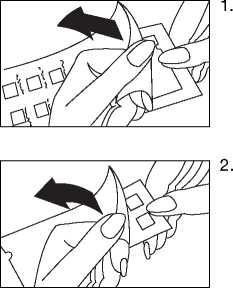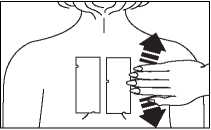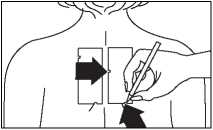True Test 24 Plaster For Provocation Test
Package leaflet: Information for the user
TRUETEST ® 24
Plaster for provocation test
TRUE Test 24 consists of 2 strips of surgical tape, each strip contains 12 patches. Each patch is coated with a film containing a specific allergen or a mix of allergens.
Panel 1
microgram/mg/
|
cm2 |
pacth | ||
|
n |
Nickel sulphate |
200 |
162 |
|
a |
Wool alcohols |
1000 |
810 |
|
H |
Neomycin sulphate |
600 |
486 |
|
□ |
Potassium dichromate |
54 |
44 |
|
a |
Caine mixa) |
630 |
510 |
|
a |
Fragrance mixb) |
430 |
348 |
|
a |
Colophony |
1200 |
972 |
|
a |
Paraben mixc) |
1000 |
810 |
|
a |
Quinoline mixd) |
190 |
154 |
|
rn |
Balsam of Peru |
800 |
648 |
|
oa |
Ethylenediamine dihydrochloride |
50 |
41 |
|
m |
Cobalt chloride |
20 |
16 |
|
Panel 2 | |||
|
03 |
p-tert Butylphenol formaldehyde resin |
45 |
36 |
|
B3 |
Epoxy resin |
50 |
41 |
|
05 |
Carba mixe) |
250 |
203 |
|
06 |
Black rubber mix (PPD mix)f) |
75 |
61 |
|
H |
Cl+Me-Isothiazolinone |
4 |
3 |
|
08 |
Quaternium-15 |
100 |
81 |
|
m |
Mercaptobenzothiazole |
75 |
61 |
|
20 |
p-Phenylenediamine |
80 |
65 |
|
a |
Formaldehyde50 |
180 |
146 |
|
go |
Mercapto mixh) |
75 |
61 |
|
23 |
Thiomersal |
7 |
6 |
|
a |
Thiuram mix0 |
27 |
22 |
a) Five parts of benzocaine, one part of cinchocaine hydrochloride and one part of tetracaine hydrochloride.
b) Five parts of geraniol and oak moss, four parts of hydroxyc-itronellal and cinnamyl alcohol, two parts of cinnamaldehyde and eugenol and one part of isoeugenol and a-amylcinnamaldehyde.
c) Equal parts of methyl parahydroxybenzoate, ethyl parahydroxybenzoate, propyl parahydroxybenzoate, butyl parahydroxybenzoate and benzyl parahydroxybenzoate.
d) Equal parts of clioquinol and chlorquinaldol.
e) Equal parts of diphenylguanidine, zincdiethyldithiocarbamate and zincdibutyldithiocarbamate.
f) Two parts of N-isopropanol-N’-phenyl paraphenylenediamine, five parts of N-cyclohexyl-N’-phenyl paraphenylenediamine and five parts of N, N’-diphenyl paraphenylenediamine.
g) Contains N-hydroxymethyl succinimide.
h) Equal parts of morpholinylmercaptobenzothiazole, N-cyclohexyl-benzothiazylsulphenamide and dibenzothiazyl disulphide.
i) Equal parts of disulfiram, dipentamethylenethiuram disulphide, tetramethylthiuram disulphide and tetramethylthiuram monosulphide.
Read all of this leaflet carefully before you start using this medicine because it contains important information for you.
- Keep this leaflet. You may need to read it again.
- If you have any further questions, ask your doctor, pharmacist or nurse.
- This medicine has been prescribed for you only. Do not pass it on to others. It may harm them, even if their signs of illness are the same as yours.
- If you get any side effects, talk to your doctor, pharmacist or nurse. This includes any possible side effects not listed in this leaflet. See section 4.
What is in this leaflet
1 .What TRUE Test 24 is and what it is used for
2. What you need to know before you use TRUE Test 24
3. How to use TRUE Test 24
4. Possible side effects
5. How to store TRUE Test 24
6. Contents of the pack and other information
1 .What TRUE Test 24 is and what it is used for
TRUE Test 24 is used to test for allergic contact dermatitis. Contact dermatitis is a skin reaction caused by exposure to foreign substances resulting in an allergic reaction.
TRUE Test 24 is a ready-to-use patch test for determining the cause of allergic contact dermatitis.
The test consists of 2 strips of surgical tape. The strips contains each 12 patches. Each patch is coated with a film containing a substance which might cause a skin reaction in sensitive people. Such substances are called allergens. Each patch contains a different allergen. TRUE Test 24 contains 24 of the most common allergens/allergen mixes.
TRUE Test 24 works by showing if you are allergic to any of the test substances (allergens) on the patches. If a substance to which you are allergic comes into contact with your skin it causes an inflammatory reaction called contact dermatitis.
These substances could be an ingredient in your perfume or aftershave, in an ointment or cream, rubber gloves, industrial chemicals, etc. The substances in TRUE Test 24 are well-known allergens. If you are allergic to the substance in a particular TRUE Test 24 patch, then the skin under that patch will react to it, becoming red and inflamed. If you are not allergic to a particular patch, the skin under it will not react. You may be allergic to more than one patch.
2.What you need to know before you use TRUE Test 24
Do not use TRUE Test 24:
• If you suffer from acute contact dermatitis. The testing should be delayed until the acute course of contact dermatitis is over.
Warnings and precautions
• You should avoid exposing the test area to the sun.
• avoid sweating profusely while wearing the patch test strips.
• if you are taking steroid medicines (e.g. prednisolone) or using steroid ointments/creams (e.g. hydrocortisone). These should not be used for at least two weeks before the test.
• if you have excited skin syndrome (angry back). This is a state of skin over-irritability caused by a reaction on other parts of the body. If you react to all of the patches, the doctor may need to repeat the test another day.
• If you have earlier had anaphylactioid reactions. The use of TRUE Test 24 should be considered carefully.
• If you have strong contact allergy. TRUE Test 24 should be used with caution since it may lead to transient flare of previous dermatitis sites.
Talk to your doctor before using TRUE Test 24 if any of these factors apply to you. Your doctor will be able to decide what to do.
Sensitisation: In rare instances you may become sensitive to a substance on the patches while using TRUE Test 24. A test reaction that appears later than 7 days after application may be a sign of contact sensitisation.
TRUE Test 24 should be applied only to skin that is:
• free of acne
• free of scars
• free of dermatitis
• in a condition, which can not interfere with the test results. You should check with your doctor if you are not sure.
Moisture around the test must be avoided. Therefore, when bathing or showering, you must be careful not to get the test panel or surrounding area wet. If the test panel does become wet it may loosen, allowing the test substances to be washed away.
Avoid any activity such as sunbathing or exercising, which may cause the patches to loosen.
Children
TRUE Test is not recommended for use in children, since its safety and efficacy have not been determined in these patients.
Other medicines and TRUE Test 24
Tell your doctor or pharmacist if you are taking, have recently taken or might take any other medicines, including medicines obtained without prescription, before TRUE Test 24 is applied. Remember that the skin specialist may not be aware of your other medicines.
Since steroids may suppress a positive test reaction, use of topical steroids on the test site or oral
The following information is intended for medical or healthcare professionals only:
An identification template is provided with each package of TRUE Test 24 for quick and easy identification of any allergen causing a reaction. To assure correct positioning, marks on the skin should correlate with the notches on the template. Notice the difference between page 1 and 2 on the template corresponding to Panel 1 and 2.
The interpretation method recommended by the International Contact Dermatitis Research Group is:
- negative reaction
? doubtful reaction: faint macular erythema only,
no or very little infiltration
+ weak (nonvesicular) positive reaction: erythema, mild infiltration, possible papules
++ strong (vesicular) positive reaction: erythema, infiltration, papules, vesicles
+++ extreme positive reaction: bullous reaction
IR irritant reaction of different types
NT not tested
Note
• Patients showing a negative reaction may still be sensitised to another substance not included in this test panel. Furthermore, false-negative results may occur. Retesting or testing with complementary substances may be indicated.
• A positive reaction should meet the criteria for an allergic reaction (papular or vesicular erythema and infiltration).
• Pustules, as well as patchy follicular or homogeneous erythema without infiltration are usually signs of irritation and do not indicate allergy.
What is important in evaluating a positive test response is not the number of plusses assigned to the test response, but determining whether the response is a truly positive reaction (caused by allergy) or a non-specific irritant reaction.
3
4
A
Neomycin sulphate and p-phenylenediamine sometimes cause reactions which may not occur until 45 days after the application of the test strips. The patient should be instructed to report this. If appropriate, an additional office visit will verify a late reaction.
Contraindications
Acute contact dermatitis. The testing should be delayed until the acute course of contact dermatitis is over.
Special warnings and precautions for use
The substances on the test panel seldom lead to sensitisation. A test reaction that appears later than 7 days after application of the test may be a sign of contact sensitisation.
Excited skin syndrome (angry back) is a state of hyperreactivity induced by dermatitis on other parts of the body or by a strong positive skin test reaction. Therefore, test results should be evaluated carefully in patients with multiple, positive, concomitant patch test results. To determine which reactions are false positive, retesting at a later date may be necessary.
The doctor should avoid applying the test on skin with acne, scars, dermatitis or any other condition that may interfere with test results.
If a severe patch test reaction develops, the patient may be treated with a topical corticosteroid or, in rare cases, with a systemic corticosteroid.
3.How to use TRUE Test 24

Peel open the package and remove the TRUE Test 24 panel.


4. The two notches on the panels (top left and in the lower edge) are indicated with a medical marking pen.
steroids equivalent to 10 mg prednisolone or more daily should be discontinued for at least two weeks prior to testing.
Pregnancy, breast-feeding and fertility
Pregnant women should not use TRUE Test 24. It is important to tell your doctor if you are pregnant or think you might be pregnant.
You should not breastfeed your baby while using TRUE Test 24.
Driving and using machines
TRUE Test 24 is unlikely to affect your ability to drive or use machines. Talk to your doctor about this if you have any concerns.
Remove the protective plastic covering the surface of the panel. Be careful not to touch the test substances.
3. Position the test on the upper back of the patient. However, the outer part of the upper arms is also acceptable. From the centre of the panel, smooth outward toward the edges, making sure each allergen makes adequate contact with the skin. The two panels are best positioned on each side of the backbone with a distance of a few centimetres.
You should wear the test strips for at least 48 hours without removing them. You should be careful not to get the test area wet (water, sweat).
After 48 hours you or your doctor may remove the panels.
When should the results be read?
Your doctor will read the test result half an hour after removal of the test and again 1 -2 days after removal of the test, when any allergic reactions are fully developed and possible irritant reactions have faded. A few allergens sometimes cause reactions which may not appear until 4-5 days after removal of the test. Please inform your doctor if this happens.
What is the doctor looking for?
The doctor will carefully examine the test area for signs of an allergic reaction. This reaction usually consists of a rash with swelling, redness and tiny blisters. Redness alone, however, does not necessarily mean that it is an allergic reaction. If you are allergic, your doctor will provide you with the following information:
• Where in your everyday surroundings, you are likely to come into contact with the offending substances.
• How best to avoid these substances. Your doctor may suggest alternatives to the items you should avoid.
You should check with your doctor or pharmacist if you are not sure.
You should contact a doctor, if you experience severe discomfort at the test site. Your doctor can decide to remove the test.
If the plaster is removed or detaches too early, it is possible that you could miss positive reactions to allergens that you are actually allergic to..
Please contact your doctor, if the plaster is removed or detaches before 48 hours.
4. Possible side effects
Like all medicines, this medicine can cause side effects, although not everybody gets them.
Very common side effects (affects more than 1 in 10 people):
• Irritation caused by the surgical tape adhesive may occur, but usually disappears rapidly.
• Long-lasting test reactions. A positive test reaction usually disappears within 1-2 weeks, whereas a long-lasting test reaction may persist for weeks or months.
Common side effects (affects more than 1 in 100 people but less than 10 people):
• Test reactions may leave a temporary area of either pale or darker coloured skin.
Uncommon side effect (affects more than 1 in 1,000 people but less than 1 in 100 people):
• A flare-up of your dermatitis.
Rare side effect (affects more than 1 in 10,000 but less than 1 in 1,000 people):
• Sensitisation to a substance on the test panel may occur with patch testing.
Reporting of side effects
If you get any side effects, talk to your doctor. This includes any possible side effects not listed in this leaflet. You can also report side effects directly via Yellow Card Scheme.
Website: www.mhra.gov.uk/yellowcard.
By reporting side effects you can help provide more information on the safety of this medicine.
5. How to store TRUE Test 24
Store in a refrigerator (2°C - 8°C).
Keep this medicin out of the sight and reach of children.
Do not use this medicine after the expiry date which is stated on the packing. The expiry date refers to the last day of that month.
Do not throw away any medicines via wastewater or household waste. Ask your pharmacist how to throw away of medicines you no longer use. These measures will help protect the environment.
6. Contents of the pack and other information
What TRUE Test 24 contains
In addition to the active substances indicated on the first page, the test contains the following excipients:
Tape of cellulose acetate with acrylic adhesive, polyester patches, povidone 90, hydroxypropylcellu-lose, methylcellulose, -cyclodextrin, sodium carbonate, sodium bicarbonate butylhydroxyanisole and butylhydroxytoluene.
What TRUE Test 24 looks like and contents of the pack
Each panel is coated with a protective foil consisting of silicone-coated polyethylene and packed in sealed pouches of laminated foil.
The Panel 2 foil pouch also contains a special type of paper (desiccant) to keep the allergens fresh during storage.
Contents of the pack: 1 or 10 test (1 test = one Panel 1 and one Panel 2)
Marketing Authorisation Holder and Manufacturer
SMARTPRACTICE DENMARK ApS Herredsvejen 2 3400 Hillerad Denmark
Distributed by:
Diagenics Ltd
South House 3, Bond Avenue, Bletchley Milton Keynes MK1 1SW, United Kingdom
This leaflet was last revised in 09/2014
52-XXXX-DCP UK
B
5
6
7
8